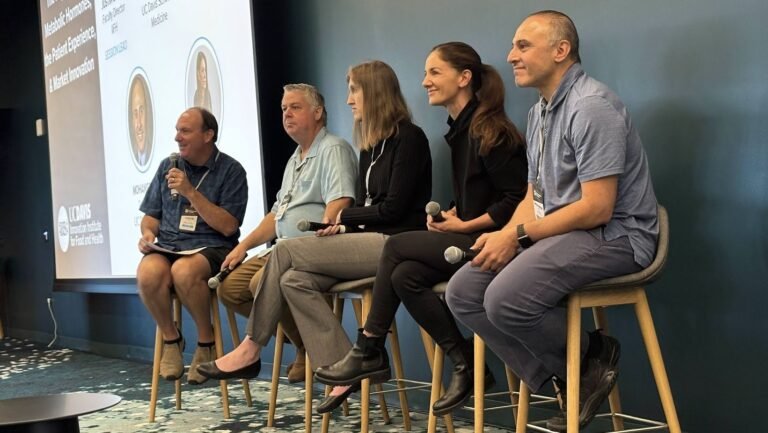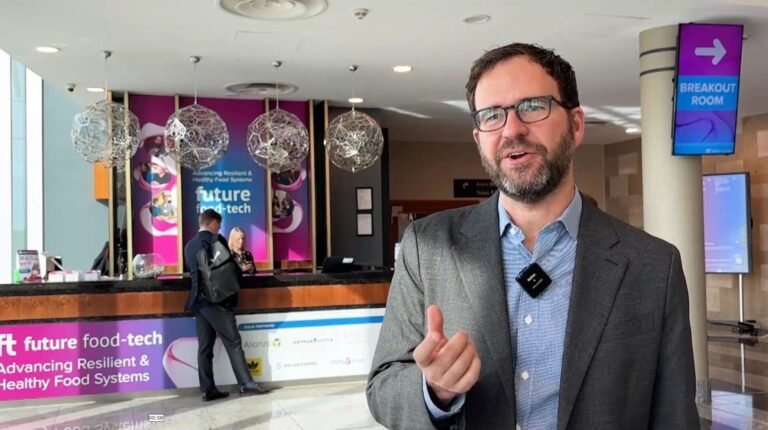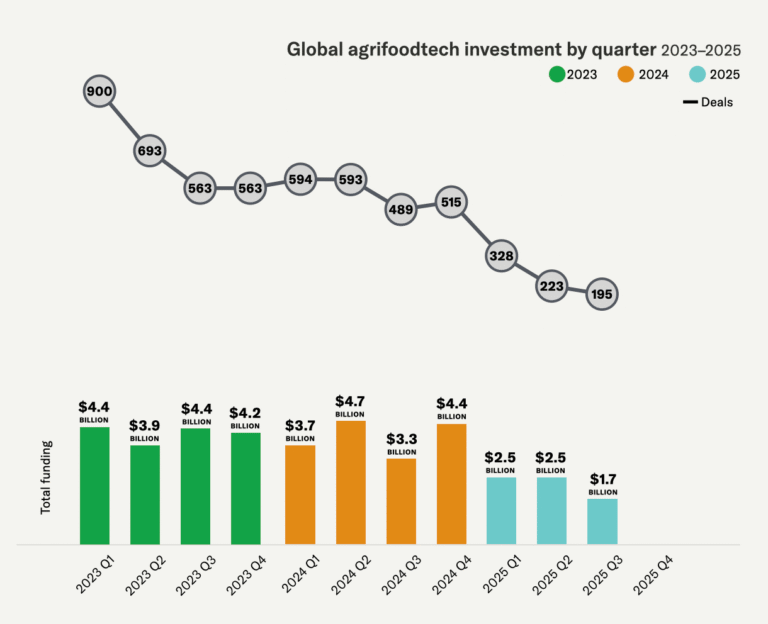From human milk oligosaccharides to enzymes that enable alt meat firms to replace methylcellulose, Danish firm Novonesis has a vast portfolio of biosolutions spanning food and ag, but is constantly scouting for new innovations.
AgFunderNews (AFN) caught up Timothy Wallace (TW), head, scouting and assessment, ventures and external innovation, at the Future Food-Tech summit in London to learn how the biomanufacturing specialist thinks about external innovation and helps startups in this space cross the valley of death.
AFN: Biomanufacturing is expensive. How can Novonesis help startups in this space make progress without breaking the bank?
TW: We want startups to succeed in the biosolutions and biotechnology space. It’s also important for them to succeed if we as an industry are to meet the sustainability goals that we’re setting for ourselves. But we also have to meet our customer needs, so we have to be selective in the startups that we interact with, work with, partner with, to those that are aligned with our strategy.
We were involved in the creation of a company called 21st.BIO together with Novo Holdings, precisely to address some of these startups that are developing great ideas, great solutions that maybe are not aligned with our overall strategy within Novonesis, but that have great potential.
21st.BIO has the ability to help these startups, also some corporates, to scale their biosolutions so that those companies are not reliant on someone like Novonesis to help them in this journey.
AFN: Aside from raising money, what are some of the key challenges startups face in this field?
TW: If you think about it along the value chain, there’s molecule discovery, expression of these molecules, upscaling of these molecules, being able to demonstrate that this can work at scale, and then actually producing them.
There’s less of a challenge, I think, upstream, because with IT, with AI, a lot of the identification and development of these molecules can be done faster and more simply than it could be done in the past.
But you still have physical products that you need to be able to produce, and so that is why you often run into bottlenecks later on in the value chain. You also need the regulatory competencies to get these products approved, and then you need access to markets. So those are the challenges that the startup has to solve, and usually the best way to try to address solving them is through partnerships with companies like Novonesis.
I think particularly in precision fermentation, the losses that you can have in downstream processing (DSP) are also a key challenge to be overcome by startups. Usually, the simpler, the more elegant your DSP is, the less losses you have, and the more competitive your solution will be.
AFN: How do you see AI impacting the biomanufacturing space?
TW: It will certainly speed up the identification and the development process, but you still need to produce a physical product. You need to be able to express these molecules in an expression system, and you need to be able to produce them in some sort of manufacturing facility.
So a lot of the challenges startups have [in crossing] the valley of death, so to speak, is making that leap from doing something that works in the lab and is an interesting molecule, and actually being able to produce it at scale.
AFN: Do you see biosolutions competing with a wider range products made from petrochemicals in future? What about fuel?
TW: The challenge associated with this space is that petroleum-based products are quite low cost, and they have been optimized over many decades. Developing biosolutions, even if they’re more sustainable, is challenging, because you have to be cost competitive. So we’re looking at high value pathways where we think biotechnology can compete with the existing petroleum-based or chemical-based pathways.
Some [of the solutions the industry is looking at to drive efficiencies in biomanufacturing] could come down to optimization of existing production methods, or actually manufacturing differently than we do. We have multi-purpose production facilities, but in some cases, to be able to be cost competitive, you need to have dedicated facilities.
In this case, we would be very much looking at enabling other companies to produce these future fuels and chemicals, but we would develop the biosolutions that they can then utilize to implement these processes in their production.
AFN: Novonesis is part of a consortium looking at converting carbon dioxide into acetate and then finding microbes that grow on acetate instead of sugar. Why is that exciting?
TW: You’re referring to an initiative backed by the Gates Foundation and the Novo Nordisk Foundation. It’s based on some past research that showed, with a lower cost of energy, you can actually convert carbon dioxide to acetate. Now, historically, you typically use glucose as the carbon source for fermentation, but it’s now potentially possible to use acetate as your carbon source [which could potentially be both cheaper and more sustainable].
The idea is that you can use this carbon source and provide low-cost proteins to low- and middle-income countries. It’s still very much in the early stages, but the potential is huge.
AFN: Are there any particular areas of focus in the food & ag space you want to highlight?
TW: One area… is the whole topic of sustainable side streams. We know that almost all of the industrial processes we have, not only in the food and agricultural space, but in other areas as well, generate side streams. And in food and ag, they are typically utilized as animal feed, so they are low value products.
There is a need for more solutions to be developed in this space [that would utilize the side streams as feedstocks for the production of higher-value products], although it’s also important to highlight that biosolutions, although they’re good, are probably not going to solve all of these problems in themselves.
So we’re also looking at collaborating, partnering with startups, with other corporates that have other capabilities than biosolutions to see what type of solutions we can develop for converting some of these side streams into higher value ingredients.
AFN: Can you provide a couple of examples of successful external collaborations?
TW: I think one of the good examples that we have of earlier stage scouting and partnerships is with a French company called Carbios. We’ve actually been working with them for a number of years now on plastic recycling [using enzymes enabling the recycling of PET without loss of quality].
Carbios was working in an industry that we did not have that much insight into but developing biotechnology, in this case, enzymes, for retaining the virgin properties of PET plastic. We collaborated with them to help them scale up those activities and also give us knowledge and exposure into an emerging market space.
We also collaborate with larger corporates; we have another venture within our group that is focused on [enzymatic] carbon capture [from flue gas]. There, we partner with an Italian engineering firm called Saipem to help develop the engineering solution that is required to complement the biotechnology for carbon capture.
The post Inside Novonesis’ playbook for external innovation in biotech appeared first on AgFunderNews.


